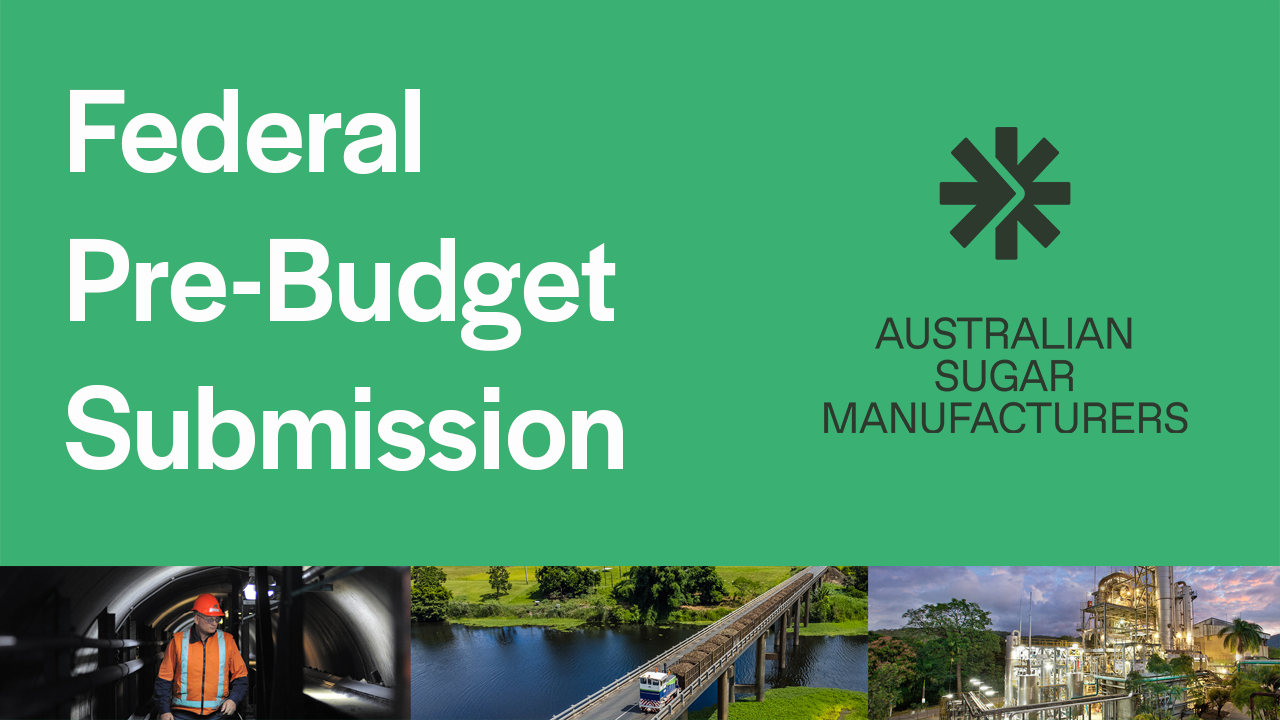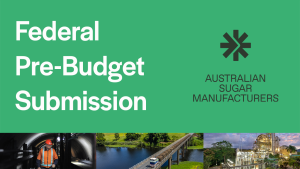Media Releases
Federal Budget: Sugar manufacturers call for a new approach to industry policy in the wake of emerging international trade uncertainty | 3 February 2025
03 February 2025


The Australian Sugar Milling Council (ASMC) has released its 2025-26 Federal Pre-Budget Submission, highlighting the crucial role that sugar manufacturing can play in addressing key national challenges. The submission underscores the need for more proactive industry policy in response to emerging global uncertainty as international trade rules come under pressure, including recent decisions by the Indian Government to resume sugar exports despite World Trade Organisation (WTO) rulings.
ASMC CEO Ash Salardini said Australia’s trade-exposed industries, and the workers and communities that rely on them, are facing growing global trade headwinds that threaten long-term viability.
“This is not business-as-usual. As a sector that exports more than 80% of its output, we need strong industry and government responses to ensure we remain competitive in a fast-changing global economy.
In addition to uncertainty around the foundations of international trade, a changing climate is impacting sugar communities profoundly, impacting harvesting, crushing and our supply chain infrastructure. Extreme weather events that were once a twenty-five year or fifty-year event seem to be now occurring every five to ten years.
“The Federal Budget provides an opportunity for the Government and industry to work together on a new approach to tackling these challenges head-on.”
The sugar industry is Queensland’s second largest agricultural exporter and the world’s fourth largest sugar exporter (2023/24), supporting around 23,000 jobs and contributing $4.4 billion annually to the national economy.
“With the right industry-government collaboration, we can continue to drive investment, innovation, and regional development in Queensland. We have a plan, and with government buy-in, we can support well-paid regional jobs, deliver affordable baseload renewable electricity, and enhance Australia’s fuel security through biofuels.”
The ASMC has called for a new strategic partnership between government and industry to improve productivity, enhance international competitiveness, and capitalise on emerging economic opportunities that neither sector can realise alone.
The ASMC’s Pre-Budget Submission outlines a strategic pathway for the future of the sugar industry. Recommendations include (summary of full recommendations attached):
- Establishment of a National Bioenergy Feedstock Strategy to ensure our energy future is made in Australia, from Australian feedstocks – this is more than an economic imperative, it is a matter of national security.
- Incentives to expand sugar’s baseload renewable electricity cogeneration capacity that can reduce Queensland’s wholesale electricity prices by 10-15% from forward projections.
- Developing an indigenous biofuels supply chain in Northern Australia to support Australian Defence capabilities, securing both national and fuel security.
- The Cane Rail Fund: Investing in critical infrastructure, including cane rail and level crossing upgrades, to remove landside chokepoints that have compromised our productivity and international competitiveness.
- Establishment of the Centre of Excellence for Advanced Sugar Manufacturing and AI that will provide the R&D and technology transfer capabilities that will ensure Australian sugar manufacturing is equipped to capture the opportunities presented to us in an everchanging global market.
“This is the right time for the sugar industry and the Government to work together to secure a sustainable and resilient future. With the right policy settings, we can turn today’s challenges into long-term opportunities for Australia.” Mr Salardini concluded.
The ASMC’s submission can be found here.
Click here for a pdf of this media release
Media Contact – ASMC: Jim Crane 0400 991 931
About the Australian Sugar Milling Council: The Australian Sugar Milling Council is the peak industry body for the Australian sugar milling sector – contributing $4.4 billion annually to the Australian economy and supporting more than 20,000 jobs. The ASMC works with its members, industry stakeholders, other industry representatives and government to develop and promote policies that enhance the sustainability, viability and economic contribution of the sugar industry in Australia.
ATTACHMENT: SUMMARY OF ASMC RECOMMENDATIONS
Industry diversification, energy, and national security
1. The establishment of a National Bioenergy Feedstock Strategy ($500,000 over four years): A Future Made in Australia starts with feedstocks grown and processed in Australia. To ensure we have a truly indigenous low carbon liquid fuel capability in Australia, the Federal Government must invest in scoping the availability and accessibility of feedstocks for bioenergy, identify the highest economic value for the feedstock (food, fuel or fibre), map out enabling freight and supply chain infrastructure, and identify any policy regulatory enablers or challenges.
2. Government incentives that recognise the energy market benefits of sugar cogeneration capacity expansion: Sugar manufacturers can provide baseload renewable electricity capacity through the cogeneration of electricity using byproducts such as bagasse. We have an installed capacity of around 340MW, and with an energy and boiler efficiency strategy, this can be increased to close to one-gigawatt.
Initial modelling suggests that the expansion of cogeneration is likely to reduce wholesale electricity prices in Queensland by 10-15% from forward projections over the next 5-10 years. The challenge is that the business case for expanded capacity on current market payments is marginal for mills, particularly with the cessation of the Large-scale Generation Certificates (LGC) program, requiring the creation new incentives.
3. Government-sector collaboration on synergistic opportunities between sugar and Australian Defence ($300,000 over four years): There are significant synergistic opportunities in North Queensland between Australian Defence capabilities and the sugar industry, both from a national security (ensuring security of fuel supply for our Defence capabilities) and economic (use of common supply chain infrastructure) perspective. These opportunities must be scoped and captured.
The sugar industry provides the opportunity for an indigenous biodiesel capacity that can help fuel our defence assets in Northern Australia, providing our forces with a secure fuel supply chain. From an economic perspective, there are synergistic freight and supply chain infrastructure that can optimise outcomes for both sectors, and these must be identified and implemented.
Overcoming the split incentives challenge with investments in the supply chain
4. Establishment of a Cane Rail Strategy and fund ($30 million over four years): The ASMC seeks $30 million from the Federal Government to go towards the $60 million Cane Rail Strategy to make much needed upgrades to infrastructure including rail bridges and level crossings. The funds will go towards projects, via a competitive tendering process, that provide the highest productivity gains for the sugar industry and highest public benefits through things like safety outcomes and reduced road maintenance.
The recently announced federal funding package to improve safety on Queensland’s Bruce Highway presents an opportunity to remove thirteen level crossings across regional Queensland, including those that intersect the Highway, reduce costs and minimise highway downtime by completing multiple projects at the same time. This approach would take advantage of the existing workforce and lane closures, increasing efficiency.
5. Addressing supply chain pinch points in the harvesting sector (<$10 million over four years): One of the biggest immediate challenges facing the sugar supply chain is the lack of availability of contract harvesters. Simply put – without harvesters we cannot get the cane to the mills for processing. The Government could provide instant asset write-off benefits to the sector for the purchase of harvesting equipment, to stimulate the growth and retention of harvesting sector businesses in the sugar supply chain.
A successful Northern Australia and Future Made in Australia agenda through a strong sugar manufacturing sector
6. Promoting the Australian Sugar Sustainability Framework ($450,000 over four years): Ensuring our sustainable practices are recognised in the markets we operate will no longer be a ‘nice-to-have’ but a future requirement for market access and demanded by customers.The sugar industry is working with Sugar Research Australia to finalise an Australian Sugar Sustainability Framework. Once complete, the Australian Government and industry must work together to promote the benefits and acceptance of this framework in international markets and jurisdictions with large buyers, and in international standards that go beyond sugar, including those for low carbon liquid fuel.
The proposed funding for promotion will provide the resources to ensure the wholesale acceptance of the Framework that will allow us to grow our $2.4 billion of annual exports.
7. Establishing the Sugar Skills and Career Start Program ($1.25 million over four years): The Sugar Skills and Careers Start Program will create pathways for those who may be under-represented in our workforce, such as young people and women, as well as identifying and creating skills pathways to fill critical shortages, including the utilisation of skilled visa pathways. This approach will provide regional communities with access to jobs that support their health and prosperity, while also enabling the sugar industry to address critical workforce shortages that threaten the effectiveness of the entire supply chain. The ASMC is seeking $1.25 million from the Federal Government to develop this program.
8. Funding for the Centre of Excellence for Advanced Sugar Manufacturing ($1.75 million over four years): Sugar manufacturing is evolving into a high-tech, 21st-century industry that must optimise limited feedstock to produce not only sugar but also a diverse range of products, including fertilisers, molasses, bioplastics, biofuels, biomethane, and electricity. Our sector needs an R&D agenda to match this ambition. We are seeking $1.75 million over four years to establish the $12 million Centre of Excellence for Advanced Sugar Manufacturing and AI.